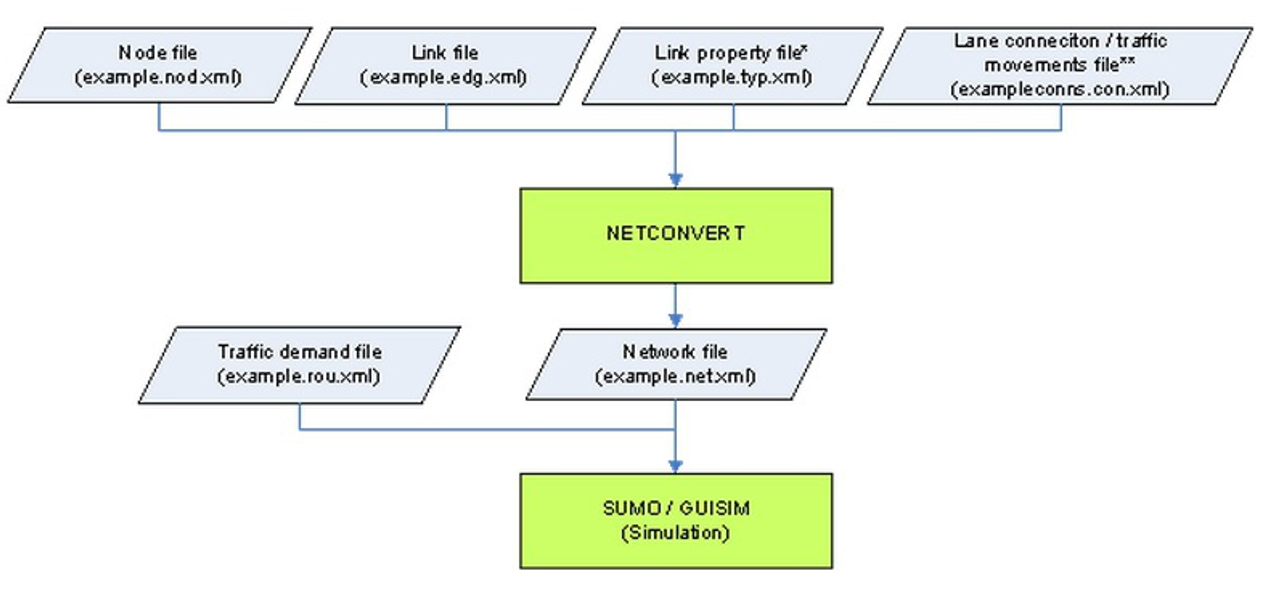SUMO¶
简介¶
SUMO,全称Simulation of Urban Mobility,是开源、微观、多模态的交通仿真软件,发展始于2000年。 它纯粹是微观的,可以针对每辆车进行单独控制,因此非常适合交通控制模型的开发。
SUMO(GUI)使用方法¶
用pi集群帐号登录 HPC Studio 平台;
在网站通过Interactive Apps->Desktop->Launch进入桌面(注意使用GPU桌面);
打开终端,通过以下命令来调用软件:
module load sumo/1.10.0-sumo
sumo-gui
从以下仿真流程图可知,每一次模拟都需要rou.xml 和net.xml两个参数配置文件。其中rou.xml用来表述交通需求,net.xml用来表述道路信息。而道路信息又由下面四个文件通过netconvert命令生成:
nod.xml: 用来描述节点信息
edg.xml: 用来描述边的信息
typ.xml: 用来描述预定义的边的类型(类似于做一个封装)
con.xml: 用来描述边到边的合并形式

具体案例¶
编写exa.nod.xml文件:
<nodes> <!-- The opening tag -->
<node id="0" x="0.0" y="0.0" type="traffic_light"/> <!-- def. of node "0" -->
<node id="1" x="-500.0" y="0.0" type="priority"/> <!-- def. of node "1" -->
<node id="2" x="+500.0" y="0.0" type="priority"/> <!-- def. of node "2" -->
<node id="3" x="0.0" y="-500.0" type="priority"/> <!-- def. of node "3" -->
<node id="4" x="0.0" y="+500.0" type="priority"/> <!-- def. of node "4" -->
<node id="m1" x="-250.0" y="0.0" type="priority"/> <!-- def. of node "m1" -->
<node id="m2" x="+250.0" y="0.0" type="priority"/> <!-- def. of node "m2" -->
<node id="m3" x="0.0" y="-250.0" type="priority"/> <!-- def. of node "m3" -->
<node id="m4" x="0.0" y="+250.0" type="priority"/> <!-- def. of node "m4" -->
</nodes> <!-- The closing tag -->
编写exa.edg.xml文件:
<edges>
<edge id="1fi" from="1" to="m1" priority="2" numLanes="2" speed="11.11"/>
<edge id="1si" from="m1" to="0" priority="3" numLanes="3" speed="13.89"/>
<edge id="1o" from="0" to="1" priority="1" numLanes="1" speed="11.11"/>
<edge id="2fi" from="2" to="m2" priority="2" numLanes="2" speed="11.11"/>
<edge id="2si" from="m2" to="0" priority="3" numLanes="3" speed="13.89"/>
<edge id="2o" from="0" to="2" priority="1" numLanes="1" speed="11.11"/>
<edge id="3fi" from="3" to="m3" priority="2" numLanes="2" speed="11.11"/>
<edge id="3si" from="m3" to="0" priority="3" numLanes="3" speed="13.89"/>
<edge id="3o" from="0" to="3" priority="1" numLanes="1" speed="11.11"/>
<edge id="4fi" from="4" to="m4" priority="2" numLanes="2" speed="11.11"/>
<edge id="4si" from="m4" to="0" priority="3" numLanes="3" speed="13.89"/>
<edge id="4o" from="0" to="4" priority="1" numLanes="1" speed="11.11"/>
</edges>
编写exa.typ.xml文件。这里就不详细描述了,因为就类似于建立一个type类供edge使用。
编写exa.con.xml文件:
<connections>
<connection from="1si" to="3o" fromLane="0" toLane="0"/>
<connection from="1si" to="2o" fromLane="2" toLane="0"/>
<connection from="2si" to="4o" fromLane="0" toLane="0"/>
<connection from="2si" to="1o" fromLane="2" toLane="0"/>
</connections>
使用netconvert命令生成exa.net.xml:
netconvert --node-files=exa.nod.xml --edge-files=exa.edg.xml \ --connection-files=exa.con.xml --type-files=exa.typ.xml \ --output-file=exa.net.xml
如果没有con.xml或者typ.xml则忽略对应的参数。使用sumo-gui查看net结果如下:

编写exa.rou.xml文件:
<routes>
<vType accel="1.0" decel="5.0" id="ACar" length="2.0" maxSpeed="10.0" sigma="1.0" />
<vType accel="0.8" decel="5.0" id="BCar" length="2.0" maxSpeed="15.0" sigma="1.0" />
<route id="route_ns" edges="4fi 4si 3o"/>
<route id="route_we" edges="1fi 1si 2o"/>
<flow depart="1" id="flow_n_s" route="route_ns" type="ACar" begin="0" end="3600" probability="0.1" />
<flow depart="1" id="flow_w_e" route="route_we" type="BCar" begin="0" end="3600" probability="0.3" />
</routes>
编写exa.sumocfg文件:
<configuration>
<input>
<net-file value="exa.net.xml"/>
<route-files value="exa.rou.xml"/>
</input>
<time>
<begin value="0"/>
<end value="10000"/>
</time>
</configuration>
在命令行中执行以下命令:
sumo-gui -c exa.sumocfg
或者直接打开sumo-gui选择open simulation,打开exa.sumocfg文件即可。 对于较为复杂的情况,建议直接使用netedit软件以图形界面的方式生成net.xml道路信息文件。